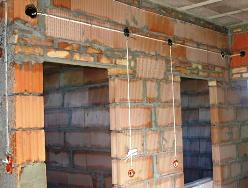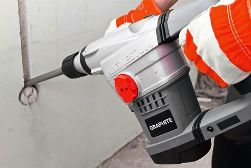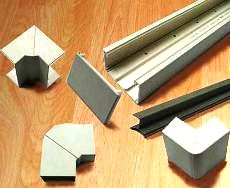Categories: Featured Articles » Electrician at home
Number of views: 125623
Comments on the article: 2
Ways of laying wires and cables for various building structures
 The way the cable is laid always depends on such factors: the type of electrical wiring (hidden / open), the category of the room (domestic, industrial, and so on) and the material from which the building is built, that is, its combustibility.
The way the cable is laid always depends on such factors: the type of electrical wiring (hidden / open), the category of the room (domestic, industrial, and so on) and the material from which the building is built, that is, its combustibility.
Ways of laying wires and cables with hidden wiring
In residential premises, most often, hidden wiring is preferred. Most people far from electrical work imagine it this way: a groove (in professional language - stroba) on the wall or ceiling in which the cables are wired, reaching for outlets, boxes and switches. Actually, this option of hidden wiring is the most common.
But what to do if the wall bearing and gating can weaken its structure? Or another option: a wooden house. In addition, it is somehow not very convenient to ditch a tree, because it is also unclear how to coat it later. And even hiding cable into a wooden wall, we grossly violate fire safety rules - the cable should not pass through combustible structures.
So, the strob and the cable hidden in it - This option is only suitable for concrete and brick walls. And even then, only in cases where there is confidence that the wall has an adequate margin of safety. Strobing the floors and, in particular, ceilings is strongly not recommended without any calculations and estimates.
So, let's go through all the ways of laying the cable as part hidden wiring on various designs.
 1. Vertical walls. Strobes for walls made of non-combustible materials we have already mentioned. In the panels of residential apartment buildings, the gates are factory-made and it is preferable to use them, since it is dubious to ditch the ready-mixed concrete panels. If the wall is wooden or cannot be ditched, then hidden electrical wiring can be arranged only under the casing of plywood, sheet GKL, GVL or SML.
1. Vertical walls. Strobes for walls made of non-combustible materials we have already mentioned. In the panels of residential apartment buildings, the gates are factory-made and it is preferable to use them, since it is dubious to ditch the ready-mixed concrete panels. If the wall is wooden or cannot be ditched, then hidden electrical wiring can be arranged only under the casing of plywood, sheet GKL, GVL or SML.
In this case, the cable will need additional protection, which is usually used as pvc corrugated pipe. But it’s better to tighten the cable not into the “corrugation”, but into the plastic or steel grounded rigid pipe. Passages through walls are also better protected by pipe cuts inserted into the holes.
2. Ceilings and Ceilings. In concrete ceilings of panel and brick houses, as a rule, there are longitudinal voids. If all your task is to hang the lamp in the holder on the ceiling in the middle of the room, then these voids can be used safely. In this case, the cable can not be protected by anything - in the thickness of the ceiling nothing threatens him.
But if you need to perform some complicated cabling on the ceiling, for example, to spotlights, then it is better to mount a separate stretch ceiling or simply sew up the ceiling with drywall. Over sheathed cable will not be amiss to protect with corrugated pipessecured with clips or mounting strip.
The ceiling of wooden houses is usually a plank structure, in the interior of which it is quite possible to place pipes for concealed wiring.
 3. Floors. The most reliable and easiest way to lay the cable in the floor is to fill it with a concrete screed. The cable is pre-mounted in the pipe (it is possible also corrugated), the position of which is fixed in any way.
3. Floors. The most reliable and easiest way to lay the cable in the floor is to fill it with a concrete screed. The cable is pre-mounted in the pipe (it is possible also corrugated), the position of which is fixed in any way.
But you can stretch the cable just under the floorboard, using a reliable and rigid pipe as a cable route. Junction boxes it is better not to place it on the floor.
4. Hollow structures and partitions. The frame of such structures is usually made of a special metal profile.The space between racks and rails is often filled with heat and sound insulating materials. In the same space, it is convenient to arrange the cable in the corrugated pipe, fixing it in the nodes of the crate.
For whatever constructions we would not lay a hidden wiring cable, it is always necessary to do this rationally, strictly at right angles. And be sure to make up for the future detailed layout of cable lines - for hidden wiring this is never superfluous.
Ways of laying wires and cables with open wiring
FROM open wiring different frills will be less. In fireproof constructions, the cable can be forwarded even directly. Fix it on any surface using special plastic brackets with studs. The brackets are selected in the size of the cable and under its shape - round or flat.
 Instead of brackets, you can use the usual thin metal strip. But cables stretched directly along the walls and ceiling do not look particularly aesthetically pleasing. Therefore, preference is usually given plastic cable ductsattached to the wall with dowels and screws.
Instead of brackets, you can use the usual thin metal strip. But cables stretched directly along the walls and ceiling do not look particularly aesthetically pleasing. Therefore, preference is usually given plastic cable ductsattached to the wall with dowels and screws.
You can use cable channels for cable installation on any, even wooden structures. Instead of a cable channel, you can use a corrugated pipe, but it does not look better than an open cable, so installation with a corrugated pipe is used only in production rooms, warehouses and other places for which aesthetics play a last role.
To date, it has become very popular when performing repairs in houses and apartments. skirting board with integrated cable duct. Using this skirting board allows you to hide the wiring cable without any damage to the interior of the room. But the cable channel built into the baseboard does not exist in large sizes - a thick cable bundle cannot be hidden in it.
For installation retro wiring harnessesmost often, special insulators (rollers) are used, reliably fixing the tourniquet and not allowing it to come into contact with the surface of the wall or ceiling. Thus, the wiring on the rollers can be laid even on combustible wooden structures.
Alexander Molokov
See also at i.electricianexp.com
:
